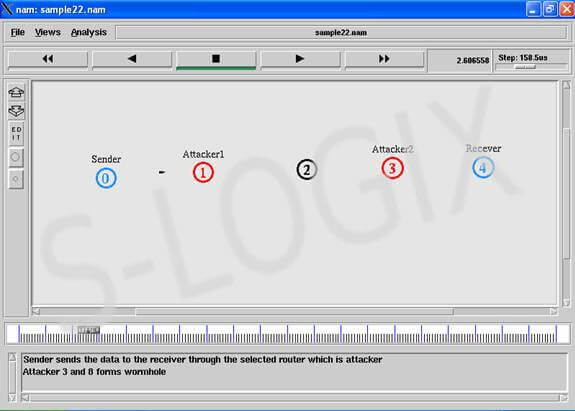A Mobile Ad hoc Network (MANET) comprises of mobile nodes that moves independently in an open environment. Communication between the nodes in a MANET is enabled with the aid of intermediate routers. The nature of MANET such as open medium, dynamic network topology, lack of centralized monitoring, and lack of clear defense mechanisms makes it vulnerable to several routing attacks. In MANET routing, there is a high probability for intermediate nodes to be malicious that might be a threat to the security. Wormhole is the common attack in ad hoc routing in which one malicious node tunnels the packets from its location to other malicious nodes. If the source node happens to choose this fake route, the attacker has the option of delivering the packets or dropping them. In sample22.tcl, the wormhole attacker does not obey the communication model. Data Transmission is established between nodes using UDP agent and CBR traffic. An adversary forms tunnel with other adversary using a direct low latency communication link.
#Filename: sample22.tcl # Define options set val(chan) Channel/WirelessChannel ;# channel type set val(prop) Propagation/TwoRayGround ;# radio-propagation model set val(netif) Phy/WirelessPhy ;# network interface type set val(mac) Mac/802_11 ;# MAC type set val(ifq) Queue/DropTail/PriQueue ;# interface queue type set val(ll) LL ;# link layer type set val(ant) Antenna/OmniAntenna ;# antenna model set val(ifqlen) 50 ;# max packet in ifq set val(nn) 14 ;# number of mobilenodes set val(rp) AODV ;# routing protocol set val(x) 500 ;# X dimension of topography set val(y) 500 ;# Y dimension of topography set val(stop) 20 ;# time of simulation end set sender 0 ;# Sender set receiver 9 ;# Receiver #——-Event scheduler object creation——–# set ns [new Simulator] # set up topography object set topo [new Topography] $topo load_flatgrid $val(x) $val(y) set god_ [create-god $val(nn)] # unity gain, omni-directional antennas # set up the antennas to be centered in the node and 1.5 meters above it Antenna/OmniAntenna set X_ 0 Antenna/OmniAntenna set Y_ 0 Antenna/OmniAntenna set Z_ 1.5 Antenna/OmniAntenna set Gt_ 1.0 Antenna/OmniAntenna set Gr_ 1.0 # Initialize the SharedMedia interface with parameters to make # it work like the 914MHz Lucent WaveLAN DSSS radio interface Phy/WirelessPhy set CPThresh_ 10.0 Phy/WirelessPhy set CSThresh_ 1.559e-11 Phy/WirelessPhy set RXThresh_ 3.652e-10 ;#250m Phy/WirelessPhy set Rb_ 2*1e6 Phy/WirelessPhy set Pt_ 0.2818 Phy/WirelessPhy set freq_ 914e+6 Phy/WirelessPhy set L_ 1.0 #configure the nodes $ns node-config -adhocRouting $val(rp) \ -llType $val(ll) \ -macType $val(mac) \ -ifqType $val(ifq) \ -ifqLen $val(ifqlen) \ -antType $val(ant) \ -propType $val(prop) \ -phyType $val(netif) \ -channelType $val(chan) \ -topoInstance $topo \ -agentTrace ON \ -routerTrace ON \ -macTrace OFF \ -movementTrace ON # unity gain, omni-directional antennas # set up the antennas to be centered in the node and 1.5 meters above it Antenna/OmniAntenna set X_ 0 Antenna/OmniAntenna set Y_ 0 Antenna/OmniAntenna set Z_ 1.5 Antenna/OmniAntenna set Gt_ 1.0 Antenna/OmniAntenna set Gr_ 1.0 # Initialize the SharedMedia interface with parameters to make # it work like the 914MHz Lucent WaveLAN DSSS radio interface Phy/WirelessPhy set CPThresh_ 10.0 Phy/WirelessPhy set CSThresh_ 1.559e-11 Phy/WirelessPhy set RXThresh_ 3.652e-10 ;#250m Phy/WirelessPhy set Rb_ 2*1e6 Phy/WirelessPhy set Pt_ 0.2818 Phy/WirelessPhy set freq_ 914e+6 Phy/WirelessPhy set L_ 1.0 $ns node-config -adhocRouting $val(rp) \ -llType $val(ll) \ -macType $val(mac) \ -ifqType $val(ifq) \ -ifqLen $val(ifqlen) \ -antType $val(ant) \ -propType $val(prop) \ -phyType $val(netif) \ -channelType $val(chan) \ -topoInstance $topo \ -agentTrace ON \ -routerTrace ON \ -macTrace OFF \ -movementTrace ON for {set i 0} {$i < $val(nn) } { incr i } { set node_($i) [$ns node] } set udp [new Agent/UDP] $ns attach-agent $node_(0) $udp set cbr [new Application/Traffic/CBR] $cbr set packetSize_ 1024 $cbr set interval_ 0.1 $cbr attach-agent $udp set null [new Agent/Null] $ns attach-agent $node_(1) $null $ns connect $udp $null $ns at 2.0 "$cbr start" $ns at 10.0 "$cbr stop" $ns at 2.0 "$ns trace-annotate \"Sender sends the data to the receiver through the selected router which is attacker\"" $ns at 2.1 "$ns trace-annotate \"Attacker 3 and 8 forms wormhole\"" set udp [new Agent/UDP] $ns attach-agent $node_(1) $udp set cbr [new Application/Traffic/CBR] $cbr set packetSize_ 1024 $cbr set interval_ 0.1 $cbr attach-agent $udp set null [new Agent/Null] $ns attach-agent $node_(3) $null $ns connect $udp $null $ns at 3.0 "$cbr start" $ns at 10.0 "$cbr stop" $ns at 3.0 "$ns trace-annotate \"Attacker forwards the data to Attacker 8 which does not forward the data to receiver\""
